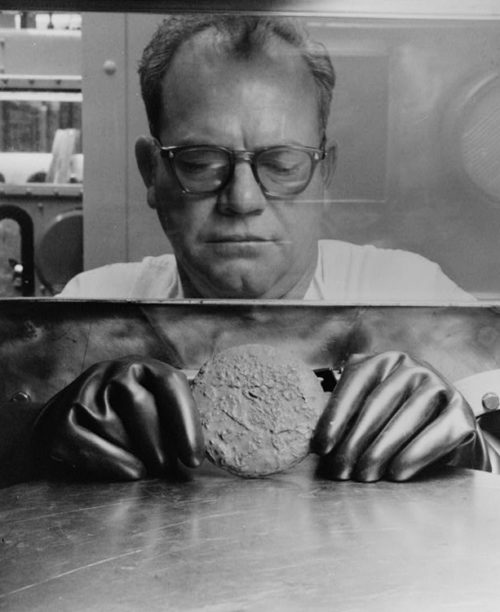
CWP Blog | CWP
Discussions with Deb: The UPPU Club
July 16, 2021
July 16, 2021
CWP
CWP Blog
There were many clubs that workers from the nuclear labs belonged to. Some belonged to Junior Chamber of Commerce, some to bowling clubs, baseball clubs, or philosophy clubs (although I hear this was largely a gathering of beer-fueled “philosophical” discussions) among others. But of all the clubs people joined, the strangest I have found is the UPPU club. I ran across references to this club while doing research on another topic and became curious. What was the UPPU club?
It turns out this was the fanciful colloquial name for a group of highly exposed workers. During the Manhattan Project years much of the work focused on processing the plutonium-239 for use in early atomic bombs. Because protective gear and monitoring were primitive during this time period some workers were exposed to hefty doses of plutonium. In 1951 Drs Wright Langham and Louis Hempelmann determined that a follow up study of these workers was desirable to determine how serious the long term health effects of their exposures would be. This program began in 1953 with 28 men (yes, all men) identified as having the highest estimated internal plutonium from exposure. The exposures were largely caused by inhalation and contaminated wounds. One of the original men in the study was excluded because he had ingested plutonium. The body burdens of these men showed they had been accidentally exposed to between 5 to over 360 times the current acceptable DOE levels. Letters were sent to them and they all consented to be part of the study.
Biochemist William Moss was one of the UPPU Club members and he described his experiences in an oral history to DOE conducted in 1994.
The men’s estimated doses were determined by plutonium uranalysis, which led to the name, UPPU (You Pee Plutonium (Pu)) Club, to describe the group. Roughly every five years the men underwent follow-up medical exams, with X-Rays, blood tests, uranalysis, and body burden testing. Until 1965 these exams were done by the men’s personal physicians. After 1972 the men returned to Los Alamos for the exams. The results from this data were published Health Physics in 1973 (Manhattan Project Plutonium Workers: a Twenty-seven Year Follow-up Study of Selected Cases), 1979 (A 32-Year Medical Follow-Up of Manhattan Project Plutonium Workers), 1985 (A 37-Year Medical Follow-Up of Manhattan Project Pu Workers), 1991 (A 42-y Medical Follow-up of Manhattan Project Plutonium Workers), and 1997 (Fifty Years of Plutonium Exposure to the Manhattan Project Plutonium Workers An Update). DOE’s Comprehensive Epidemiologic Data Resource (CEDR) has been collecting data on these workers’ health. LAUPUA01_d1 – 26 Plutonium Exposed LANL Workers 42 yr will take you to their information.
So how did the members fair?
- In 1973 the AEC determined, “To date, none of the medical findings in the group can be attributed definitely to internally deposited plutonium. The bronchial cells of several of the subjects showed moderate to marked metaplastic change, but the significance of these changes is not clear. Diseases and physical changes characteristic of a male population entering its sixth decade were observed. Because of the small body burdens on the order of the maximum permissible level in these men so heavily exposed to plutonium compounds, we conclude that the body has protective mechanisms which are effective in discriminating against these materials following some types of occupational exposures. This is presumably explained by the insolubility of many of its compounds. Plutonium is more toxic than radium if deposits in certain body tissues, especially bone; however, from the practical point of view, plutonium seems to be less hazardous to handle.”
- In 1979 DOE found that “All other medical findings in these individuals appear to be within usual expectations for their ages. It is out conclusion that none of the positive findings in these medical examinations can be attributed to the plutonium body burdens.”
- The 1985 report echoed this, “None of the positive findings on medical examinations of these individuals can be attribute to their Pu depositions in our opinion.”
- The 1991 paper states, “Furthermore, comparison with their contemporary Los Alamos workers hired in 1944-5 indicates the mortality rate is not increased in the Pu exposed group. It is concluded that the mortality experience of these Pu-exposed men has not been excessive for the first 42 years after exposure.” The paper also discusses the bone cancer of one club member in detail.
- The 1991 paper also speculates that low-dose radiation improves immune function, “These findings may suggest an enhanced immune-response potential in some individuals after plutonium deposition due to decreased numbers of suppressor cells. Further investigations into the effects of chronic low-dose radiation to the immune system are needed.”
By 1997 nineteen of the members were still alive and eight had suffered from cancers of the prostate, lung, or bone. DOE stated that the “Mortality from all cancers was not statistically elevated.” Unfortunately I was not able to find the full published paper of the 1997 paper, nor any further updates to see how the UPPU Club members are doing currently.
